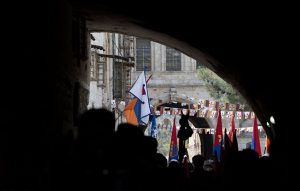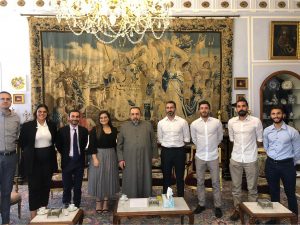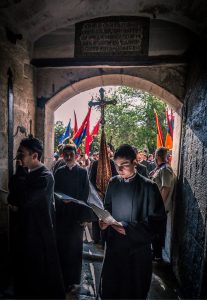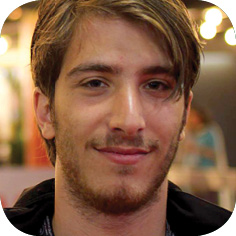“Chek kider, vor Baderiarkin hantibelou hamar bedk eh 10 vayrgyan ganoukh nergayanal?” queried, rhetorically, the gatekeeper of His Beatitude Archbishop Nourhan Manougian’s patriarchal office.
Confused? Good.
In order to understand the Armenian community in Jerusalem, or more specifically, the one associated with the Armenian Quarter of Jerusalem (a distinction I stress, for merely residing within the oldest enclave of the Armenian diaspora isn’t sufficient in order to belong), one must know and feel the Vunk, which means convent in – you guessed it – Armenian. Feel a convent? I’ve always had a hard time explaining to my “non-conventeer” (let alone non-Armenian) friends the concept of living in this convent, a literal gated community in our case, where, come midnight, an actual gate is closed, effectively preventing any entry or exit, barring an emergency or work-related responsibilities, in which case a smaller door within the larger one is used to provide passage.
“What do you mean the gate is closing? You have a curfew?!” they’d ask, amused, as I rushed with Cinderellaesque fashion – minus the dress, tiara, and glass slippers – from Bab-al-Khalil to our quarter, desperately hoping to be on time lest I face the ire of the guards.
“Kegham Jan, chi gareli!”* exclaimed Armen, the night guard, for the millionth time; and for the millionth time, I’d retort “Traffic gar, ge neres Armen Jan!”** If that didn’t pan out, we’d resort to scaling one of the pipes situated on a five-meter-high wall adjacent to Mardigs Mini-Market (a beloved generational staple within our society), carrying tales of shattered tailbones to heighten our senses, imbuing us with the virility of a Hollywood stuntman in an otherwise Dionysian predicament, to successfully reach the top of St. James Cathedral, a return back home, to confinement, till five in the morning, when the gate is once again opened. Ridiculously feudal in this day and age, but it would be too reductive on my part not to acknowledge that these very walls insulate within them traditions and values that are hastily dissipating in a world that increasingly seeks to equalize rather than celebrate cultural differences.

Vunk means waking up to the morning bells of St. James Cathedral, to your grandmother stuffing both your pockets with Kleenex (accept no substitute); Vunk means passing through your neighbor’s laundry laid on wires lifted sky-high with wooden poles, a whiff of detergent, inevitably invasive yet eerily soothing, as you reach the Bezdig Pag (small yard), before eventually coalescing with friends emerging from the myriad of alleyways leading to the Medz Pag (big or main courtyard) on your way to the Tebrotsi Pag (schoolyard) of Sts. Tarkmanchatz Armenian School. Vunk means waiting for lunch break to have Jawwad’s ka’ek, the ratio of salt to za’atar dehydrating your soul; Vunk means playing Kar Kar (hopscotch), Pernel Pernel, and Gouleh (marbles) opposite the Calouste Gulbenkian Library, one of the world’s most comprehensive Armenian literature centers with its 100,000-book collection. Vunk is folks converging at Mardigs Mini-Market after work, generating a rumor mill that, if converted to energy, would be capable of sustainably powering Jerusalem and a few neighboring cities.
O Vunk, my Vunk, my cradle, my home, my….Fine, fine I’ll shut up. You get the gist. But in truth, I jest lest I weep, for the time of nostalgic adulation is over given the existential crisis gripping our community.
There has been a clergy-people and people-people cleavage, a three-way disarray of communication, contributing to a widening schism within the convent. Allow me to very briefly, to the best of my ability, elucidate on the main factions involved.

The Armenian Patriarchate of Jerusalem is the home of the Brotherhood of St. James, a monastic order of about 60 members worldwide, under the umbrella of the Armenian Apostolic Church. A bastion of Christianity in the Holy Land, safeguarding a plethora of Christian sites, notably the Church of the Holy Sepulcher, alongside the Roman Catholics and Greek Orthodox; the zenith of our cooperation being highly, highly evident during Easter. It also serves as a mini-welfare state, providing residence, education, and spiritual guidance to the populace: The Theological Seminary of the Patriarchate tasked with the formation of future priests, historically orphans, brought in from the diaspora and Armenia, aspiring to ordination and a lifelong commitment to clerical duties; the Ashkharagans (from this earth), or civilian population, focusing on sports and scouting, stemming from the three main clubs located in or around the quarter – Homenetmen, with close ties to the Armenian Revolutionary Federation Party; Hoyetchmen, with close ties to the Armenian Democratic Liberal Party; and J.A.B.U. (Jerusalem Armenian Benevolent Union), an apolitical organization.
Why the political clarification, you ask, for an audience that by and large refers to us as simply Il-Arman? Precisely for this reason! We are known as Il-Arman to Palestinians, and Saghimahay (Jerusalemite Armenian) abroad, an identity that is one and the same should you distill the linguistic variables. An identity that transcends political allegiances. An identity worth protecting when we are blessed with this haven in the heart of the Old City of Jerusalem, this Vunk! Yet our intra-communal differences, rather than enriching us, have stifled us. I’m tempted to shed light on our weighing dissonance, on our tribalism, but I digress, for the urgency should lie in seeing one another, not dabbling in our dirty laundry. When, who, why, where, and how. Pointless. History shouldn’t burden us, and burden us it shan’t.

Enter Armadner (“roots” in Armenian), an organization founded on July 19, 2019, for the preservation and continuity of our community, under the patronage of His Beatitude Archbishop Nourhan Manougian. Our goal is to serve as a bridge, both intra- and inter-communal, to create dialogue and understanding whilst overseeing the infrastructural development of religious, cultural, social, and economic endeavors in order to pave the road for a sustainable and durable future. Barely afoot, we have in a relatively short time managed to set historic precedents: For the first time ever, on September 21, the independence day of Armenia, we organized a reception in the Tebrotsi Pag that gathered all the members of our community. For the first time ever, we managed to erect a Christmas tree in the Medz Pag – a sobering and joyful achievement. For the first time ever, we are working hand-in-hand with the patriarchate, renovating the Edward and Helen Mardigian Museum of Armenian Art and Culture, scheduled to open next year, showcasing our unique and resilient heritage, complemented by a cornucopia of priceless, timeless artifacts and manuscripts, in a technologically integrative multimedia setting, as well as a courtyard café that offers everyone a glimpse of traditional Armenian cuisine. All wonderfully sewn together by world-renowned academics Claude Mutafian and Raymond Kevorkian, references in the field of Armenian history; and last but certainly not least, Harout Bezdjian, a talented museographer with an eye for the futuristic, in charge of the artistic direction of this project, proving that tradition and modernity can coexist.

“Don’t you know that one has to be 10 minutes early when meeting with the Patriarch?” was the question we were asked by the gatekeeper. Evidently, we didn’t. We weren’t aware of how to act or what to expect at the precipice of our very first meeting. Were we confused? Yes. Were we afraid? Even more so. Were we motivated? Absolutely. You have to understand that such a union, between clergy and laypeople, had never been accomplished in the 1,600-year history of our community. We were early yet very late. Late to put aside differences for the common good as we entered the room, leaving preconception and past frivolities at the door, and to our collective relief, conversed with a man who shared the same vision for the benefit of our people. All it took was the willingness to talk.
To the huffers and puffers: for every mention of the word Armenian, take a shot of your most potent disillusion, and leave reality to us. To the rest: come, sit, let’s talk.
*“Dear, this isn’t possible!”
**“There was traffic, dear Armen, forgive me!”


